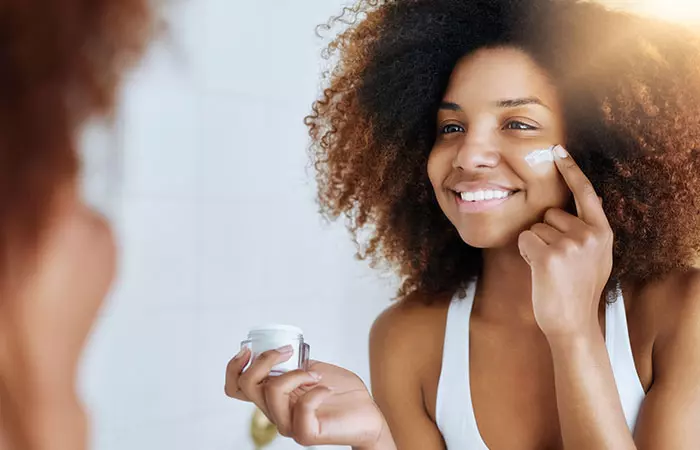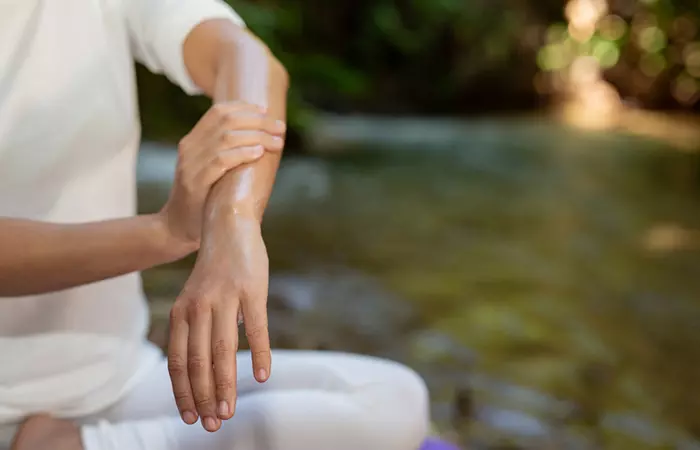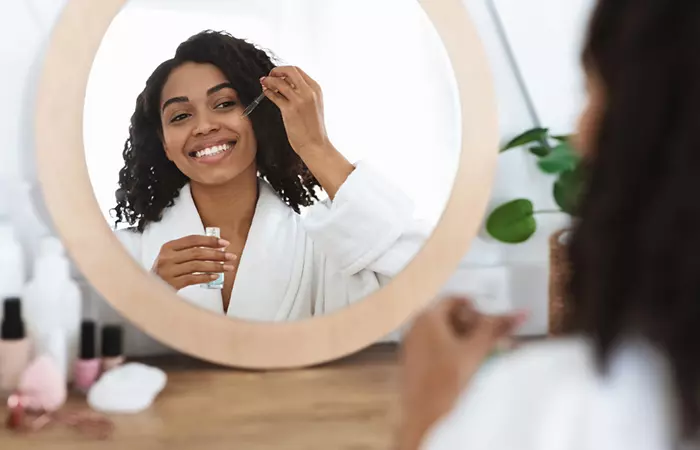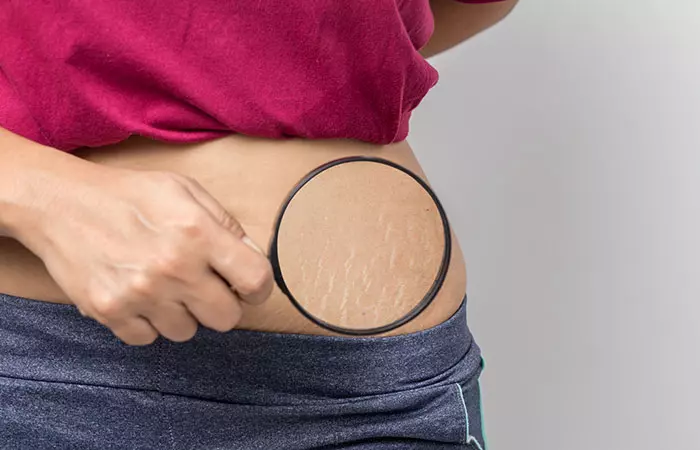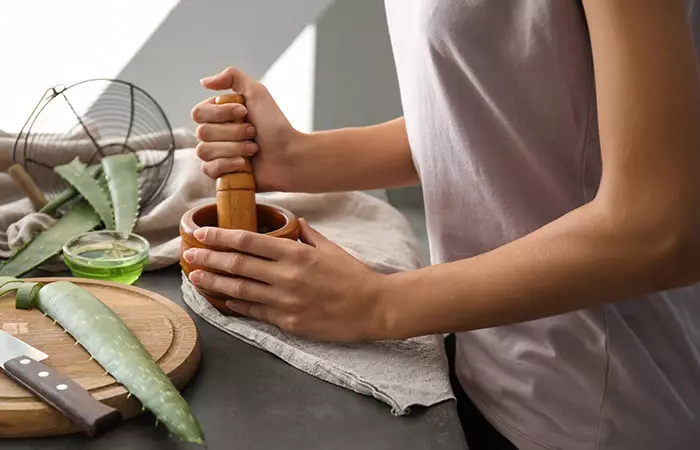This nutritious oil is used to handle many skin and hair issues (1). It is also known for its wound healing properties, and it can effectively manage mosquito bites. Want to know more about aloe vera oil and how is it prepared? Scroll down to learn more!
The Origin Of Aloe Vera Oil
Since the early 1800s, aloe vera (Aloe barbadensis miller) is used to treat chronic skin diseases, bruises, burns, wounds, and even constipation. These properties are attributed to the succulent leaves of aloe vera (1). What Are Its Benefits? It moisturizes and repairs the skin, promotes hair growth and removes dark spots. Who Can Use It? All except people who have hypersensitive or infected skin. How Often? It can be applied on the skin daily. Caution It might cause skin irritation, such as hives and rashes in some individuals.
Their yellow sap and green skin contains anthraquinones, glycosides, carbohydrates, and proteins. These two portions are commonly blended with mineral oil, milk, wine, water, and honey for medical applications (1), (2). When you combine aloe extracts with oil, you get aloe vera oil. You could use mineral oil, soybean oil, olive oil, jojoba oil, or coconut oil – any carrier oil of your choice – to obtain this infusion. You need to macerate aloe pieces/pulp in the carrier oil and let it steep/boil for a while.
How Does It Help Your Body?
Due to the extraction steps, aloe vera oil is rich in phytochemicalsi A group of chemical compounds in plants and fruits that provide basic nutrition and reduce the risk of diseases in humans. . This oil has potent anti-inflammatory, wound healing, and antimicrobial effects (3). This oil contains growth-stimulating compounds, like glucomannans. They stimulate the synthesis of collagen and other factors involved in skin repair and hair growth. Since aloe vera is rich in vitamins and minerals, its oil may also rejuvenate your skin and hair cells (1), (4). Go through the following section to know how aloe vera oil can benefit you.
What Are The Benefits of Using Aloe Vera Oil?
Aloe vera oil moisturizes and protects your skin. It may boost hair growth and nourish dry and flaky scalp if used regularly. You can use this oil as the following.
1. Skin-lightening Agent
Aloe vera plant contains aloesin, a compound that impacts your skin tone. Aloesin interferes in the production of melanin. It blocks the production of melanini The natural pigment produced by melanocytes in the body that is responsible for the color of eyes, skin, and hair. to lighten the skin color (5). Aloe vera gel can be included in your skincare routine for amazing benefits, such as moisturizing, healing and even anti-inflammatory benefits. UV rays also induce dark spots and pigmentation. Topical application of an aloesin-rich preparation may cause a visible reduction in the intensity of the spots (5). Combining extra virgin coconut oil with aloe vera extracts showed 5-100% skin-lightening intensity. This aloe vera oil preparation did not show rancidity, undesirable oxidation, or unpleasant odor when used with turmeric (6).
2. Moisturizer And Mosquito Repellent
A mixture of aloe vera gel and olive oil can be used as a plant-based topical mosquito repellent. A study was carried out to observe the effect of aloe-olive oil in preventing mosquito bites. The volunteers who applied this oil on naked skin reported fewer mosquito bites as compared to their counterparts. They had smoother skin than earlier (4). The volunteers who applied this essential oil on naked skin reported fewer mosquito bites as compared to their counterparts. Using this oil could protect you from malaria, dengue, and parasitic diseases as well as nourish your skin (4). This study reported mild irritation/sensitivity in subjects that used aloe oil with higher aloe vera gel proportion (4).
3. Anti-acne Agent
A study found that a combination of aloe vera and ocimum oil could help reduce acne lesions. Aloe had a synergistic effect on the anti-acne properties of Ocimum gratissimum oil (7). Applying the mixture for 2-5 days reduced acne lesions by 50%. The antibacterial activity of aloe gel helps treat chronic and highly inflamed cases as well (7). You can also use aloe vera for acne by combining aloe vera gel and tea tree oil for an anti-acne treatment. Tea tree oil decreases sebum secretion and suppresses the growth of acne-causing bacteria. Combining it with aloe vera gel increases its anti-acne activity (8). The components of this gel, including mannose-6-phosphate, reduce erythema (red bumps) and inflammatory scars in the subjects. This combination also caused rapid tissue restoration and opening of clogged pores in affected areas (7), (8).
4. Hair Growth Booster
Aloe vera is one of the popular home remedies for hair loss and repair. Its pulp, leaves, and oil are commonly used on dry scalp, damaged hair ends, and colored hair (9). You can boil the leaves and apply the cooled liquid to your hair. Massaging aloe gel/extracts with oils (olive, coconut, wheat germ, sesame, avocado, almond, fish, and castor) into your scalp will also give good results (10). Using aloe vera for hair can help maintain the pH balance of the scalp and stimulate the growth of well-moisturized, rejuvenated, and dandruff-free hair (10).
5. Hydrating And Anti-aging Solution
Dry skin makes wrinkles and fine lines more visible. Lack of moisture in the layers of your skin results in flaky skin with shrunken pores (11). This worsens the sensitivity of your skin and may even lead to psoriasisi A chronic skin disease that causes rashes and itchy, scaly patches on the skin and mainly affects the scalp, elbows, trunk, and knees. . Aloe vera contains mucopolysaccharides that trap/bind moisture in your skin. Applying aloe vera gel-based cream/lotion/oil improves the integrity of sensitive and dry skin (1). It stimulates the production of collageni The main protein produced by the body that is responsible for the function and structure of the skin, connective tissues, bones, and cartilage. and elastin fibers, making your skin more elastic, plump, softer, and younger (1).
6. Stretch-mark Healer
Stretch marks or striae are long scars with underlying thinning of the skin. Pregnancy, rapid weight change, weightlifting, and continuous stretching of the skin commonly cause them. Striae can cause psychological and sexual problems (12), (13). There is no definite strategy/drug regimen to treat them. Applying steroid-based creams can be a temporary and risky solution. However, aloe vera gel with carrier oils is considered in alternative medicine (12). Sweet almond oil-aloe vera gel creams control the itching and redness of stretch marks. Applying them topically can also prevent striae from spreading across the abdomen, especially in women who are not pregnant (13).
7. Dandruff Fighter
Aloe vera oil may aid in managing dandruff. It possesses anti-inflammatory and antimicrobial properties that may soothe the scalp, combat the dandruff-causing Malassezia fungus, and help eliminate dandruff flakes (14). Regular use of aloe vera oil may provide relief from itching and irritation, thus improving your scalp health and appearance (15). Its gentle therapeutic properties make it a good choice for addressing dandruff while maintaining overall hair and scalp wellness. However, it is important to note that research is limited in this regard. You can apply it as a regular hair oil or even use it as a serum after washing your hair. Now that you are aware of its benefits, don’t you want to give aloe vera oil a shot? What if you could make it on your own? Yes! You can make a crude preparation of this oil at home. Get the recipe below.
How To Make Aloe Vera Oil At Home
Before you start, let’s get this straight. Aloe vera oil will not be a clear, viscous liquid (like other oils). It will be slurry of aloe pulp that is partially dissolved in oil.
Aloe vera leaves Virgin coconut oil or any carrier oil of your choice (mustard seed, sesame, castor, olive, or almond oil) Knife A medium-sized mixing bowl Saucepan/deep vessel (to boil contents)
You can use this as a natural remedy for your face, skin, and hair by adding it to packs and masks. You can also topically use aloe vera for lips as a nourishing treatment. However, do a patch test to ensure that you are not sensitive/allergic to the preparation. Which is better for the face: aloe vera or coconut oil? Both have their own benefits for the skin. While aloe vera helps moisturize the skin, soothe sunburns, and lighten blemishes, coconut oil helps keep the skin hydrated, reduce inflammation, and help heal damaged skin. How long does aloe oil last? It can last for about 8-10 months without getting spoiled. How is aloe vera oil different from aloe vera gel? Aloe vera gel is obtained from the clear gel inside the aloe leaf, whereas aloe vera oil is made by infusing this gel with carrier oil and heating it until the mixture turns brown and translucent. Is aloe vera oil safe to ingest? No, aloe vera oil is not safe to ingest as the ingestion of aloe preparations is associated with several health risks, like kidney failure, hypersensitive reactions, and diarrhea (14). Even if you decide to consume aloe juice, it is recommended to consult your doctor before doing so. How should aloe vera oil be stored? You should store aloe vera oil inside a refrigerator in an airtight container to prevent it from going bad and extend its shelf life. What is the recommended dosage of aloe vera oil? There is no recommended dosage of aloe vera oil. It is better to use it topically and avoid ingestion to prevent health risks like diarrhea and kidney failure (14). Is aloe vera oil suitable for all skin types? Yes, aloe vera oil is suitable for all skin types as it contains natural ingredients. You can also choose different carrier oils like jojoba and coconut oil while making it, depending on your skin type. However, if you have sensitive or acne-prone skin, make sure to perform a patch test before using the oil to avoid skin irritation.
Illustration: What Is Aloe Vera Oil? Its Benefits Uses & How To Make It
